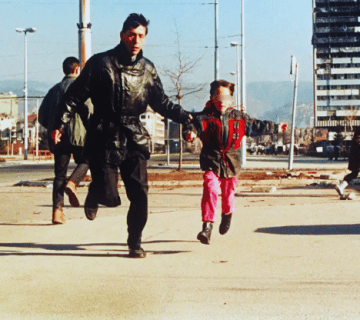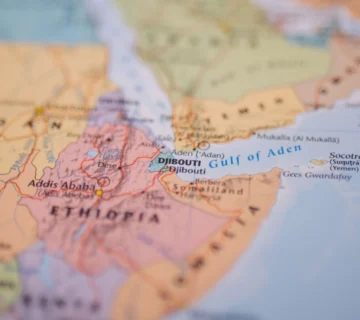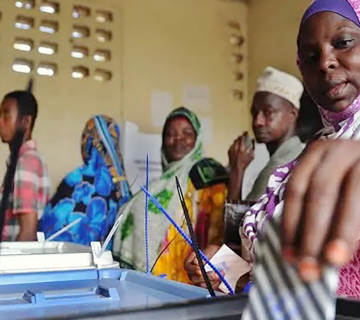After the exit of Presidents Mwai Kibaki and Daniel Moi (Kenya), Olusegun Obasanjo (Nigeria), Nelson Mandela and Thabo Mbeki (South Africa) and Muammar Gaddafi (Libya) who influenced the stability and unity of the first decade of the 21st century Africa, the regional influence of traditional leaders – Nigeria, South Africa and Kenya – seems to decline at a time when regional institutional frameworks for peace and security are weakening. This leadership vacuum is reproducing the “continent in crisis” phenomenon in Africa, with coups making a resilient come-back, conflicts becoming more intractable and foreign interference more perverse.
In early 2000s, a new and bold African leadership emerged on the premise of “African Solutions for African Problems” to pull the region from the crisis of the “lost decades” between 1970s – 1990s. Africa had been plagued by economic stagnation, political instability – 100 coups and an average of 4.9 civil wars per year, ethnic violence and social unrest, which had tested the limits of post-independence governance policies, foreign aid and loans, regional diplomatic leadership and most importantly, foreign intervention.
From establishing the African Union (AU) and revitalizing regional economic communities (RECs) and African diplomacy, South Africa, Kenya, Nigeria and Libya played a critical role in shaping the 2000 – 2010 decade, shortening the time taken to resolve crises and mainstreaming sustainability in crisis response and peace efforts. However, the speed at which crises are resolved has dramatically worsened since the early 2010s when the Arab Spring set in. The region is tottering on the brink of a deeper crisis, as the influence and constructive role of the AU, RECs, Nairobi, Pretoria and Lagos increasingly wane. The leadership gap is steadily entrapping Africa in strategic crises which threaten regional security and stability.
The Coups and Diplomatic Revolution in West Africa
A wave of military coups and the rise of military governments have hit Africa, with at least 14 coups since 2010, mainly in West Africa. Five (5) of the current six (6) military governments in the world are in Africa – Burkina Faso, Guinea, Mali, Niger and Sudan. Two more – Chad and Gabon – have morphed into civilian governments through opaque elections to merely blunt international diplomatic pressure. In reality, Chad and Gabon maintain significant military influence in politics, considering that the military coup leaders Mahamat Deby and Brice Nguema respectively won the elections to become presidents.
The coups are a fundamental contravention of the African Charter on Democracy, Elections and Governance which seeks to entrench democracy and political stability in Africa. The efforts by the international community and Economic Community of West African States (ECOWAS) to pressure for democratic transitions have failed. Mali and Burkina ended military cooperation agreements with France and expelled French troops, prompting Niger to adopt a similar policy towards the United States of America. These highly televised events promoted a deep anti-Western sentiment across West Africa and dampened the pro-democracy policy by ECOWAS governments towards Burkina Faso, Guinea, Mali and Niger, given the lack of domestic support by the ECOWAS publics. The ECOWAS-imposed sanctions and blockades, and attempts at military intervention were quickly thwarted by the unexpected military and economic alliance between Mali, Guinea, Burkina Faso and Niger, dubbed the Alliance of Sahel States (AES).
Further diplomatic efforts by regional powers – Ghana, Nigeria and Senegal – have failed to produce a viable transition path, demonstrating their increasingly limited capacity for regional leadership and effective diplomacy. In the 1990s, ECOWAS in solidarity and under the strong leadership of Nigeria, successfully deployed troops to quell civil unrest in Guinea Bissau, Liberia, and Sierra Leone. Similar threats for military intervention in 2017 pressured former Gambian President Yaya Jammeh to relinquish power to Adama Barrow, who had won the December 2016 presidential elections, ending the political crisis. The AES diplomatic revolution has thus precipitated the geopolitical decline of the internally-drained Nigeria and left ECOWAS ineffectual.
Intractable Crises
The average time and speed for resolving a crisis in Africa may now awfully pan beyond 10 years as seen in Libya, South Sudan and Sudan. Libya sunk into instability in 2010 at the height of the Arab Spring and 15 years later, there is no unitary government in the country. The transitional government led by Mohamed al-Menfi in Tripoli, a rebel coalition led by Khalifa Haftar in Tobruk and other groups of militias, wield varying territorial control in Libya technically separated by a stalemate.
South Sudan slid into civil war in 2013 which despite settlement in 2018, left the country trapped in a state of “the permanence of the temporary”, given the ever-fragile and unending transition. The 12 year slow implementation of the 2018 peace agreement, has seen numerous tension-inspiring revisions of timelines, intermittent hostility and serial election postponements. This has only increased the risk of South Sudan’s relapse into civil war.
The hope for a full transition after the popular ouster of President Omar Bashir (1989 – 2019), was quickly dimmed by a momentary military power grab in 2019 and a joint military coup by Sudan Armed Forces (SAF) and Rapid Support Forces (RSF) in 2021. This series of events set the momentum for the devastating civil war which broke out in April 2023. The civil war has no end in sight yet and risks fragmenting the country after RSF announced a parallel government over the territories it controls this year, even as SAF consolidates more territorial control and battle victories in the recent months. About 30 million people in Sudan are in need of humanitarian assistance as a result of the conflict. Multiple and parallel diplomatic efforts to resolve the crisis have failed, with the externally backed primary actors, SAF and RSF, bent on the quest for military victory.
The External Influence
When the African Union was founded in 2002, a bold peace and security institutional architecture was birthed with complementary early warning, mobilization and operational units at sub-regional (RECs) levels. However, this institutional framework has weakened in capacity. Africa has thus been resorting to mostly ad hoc crisis response strategies such as the joint multinational taskforces (MJTFs), which are financed largely by external partners such as the United States of America and the United Nations (UN) among others. In consequence, external partners and players have become more active in Africa’s crises either as mediators or destabilizing proxy sponsors of factional conflicts in the region.
In all the active conflict theatres in the Africa today, external actors have infiltrated and embedded their interests, with the effect of making military policy more attractive than peace processes. This is exemplified by the external arming of RSF and SAF in Sudan, which has disincentivized the parties’ from committing to peace talks. The globally televised capture of European mercenaries during the conflict in eastern Democratic Republic of Congo (DRC) which broke out in January 2025 is yet another reminder of how external interests now lie at the core of Africa’s crises.
There has been a demonstrable lack of solid African-led processes to resolve the crises in Sudan, South Sudan, Libya, the coup-plagued West Africa, the Ethiopia – Somalia territorial dispute and most recently, the conflict in eastern DRC. The ineffective regional diplomacy has not only revealed fundamental capacity gaps in regional institutional mechanisms but also inflicted reputational damage on apparent regional leaders – Nigeria, South Africa and Kenya. The net effect is the loss of leverage and credibility for African processes, and the yielding of the undesired opportunity to external players to influence the security domain in Africa.
Crises in the region have been effectively left to external players, to either mobilize resources and diplomatic capital for peaceful resolution, or to mobilize military support for warring factions and make them intractable.
It has taken Qatar’s mediation to de-escalate tensions in eastern DRC, following collapsed efforts separately and jointly by East African Community and Southern Africa Development Community (SADC). Similarly, it took the intervention of Turkey to ease tensions between Ethiopia and Somalia, and pull the Horn of Africa from the brink of war involving Ethiopia, Egypt and Somalia. Individual crisis-hit countries are also soliciting external defense and security support as seen in Mozambique, Central African Republic and Mali where Russian entities are active, Somalia where Turkish entities are active, and DRC which is in the process of engaging the United States of America in a “minerals for protection” arrangement. Before the diplomatic revolution by AES in West Africa, Burkina Faso, Mali and Niger had nearly similar transactional arrangements with France and United States of America.
It is thus most likely that the crises in Sudan, Libya and South Sudan which involve strong external forces, will similarly be determined by external actors, as regional players continue to falter on the periphery.
The Bottomline
There is urgent need for Kenya, South Africa and Nigeria to redeem their diplomatic reputation and credibility, and restore their traditional role and influence over the peace and security domains in the region. The three capitals should mobilize support within RECs and support capacity building programs for RECs and other institutional crisis response mechanisms, to be able to provide effective regional leadership. So doing will not only recall the crises facing Africa today, but also give true meaning to Africa’s sovereignty and the “African Solutions for African Problems” philosophy, and build lasting regional resilience against future crises.
Edmond Pamba is a Researcher at The HORN Institute.
Photo Credits: African Union



